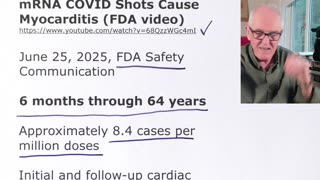Premium Only Content

Analysis, covid vacines and road accidents
COVID Vaccine Hesitancy and Risk of a Traffic Crash
https://www.amjmed.com/article/S0002-9343(22)00822-1/fulltext
Background
Coronavirus disease (COVID) vaccine hesitancy,
is a reflection of psychology that might also contribute to traffic safety.
So
People that take covid vaccines are the sort of people who have less traffic accidents
People who do not take covid vaccines are the sort of people who have more traffic accidents
Methods
Population-based longitudinal cohort analysis of adults
Determined COVID vaccination status from electronic medical records
Traffic crashes requiring emergency medical care
Subsequently identified accidents from all (178) hospitals
One month follow-up
Results, (2021)
N = 11,270,763
Total traffic accidents, 6,682
Unvaccinated, 16%
Vaccinated, 84%
Unvaccinated individuals
1,682 traffic crashes (25%)
Equal to a 72% increased relative
Confidence interval, (95%) 63% to 82%
(P < 0.001)
What about
Socioeconomic status
Alcohol
Sleep apnea
Diabetes
Depression
Dementia
Hypertension
Cancer
Covid infection
Equal to a 48% increase after adjustment
Confidence interval, (95%) 40% to 57%
(P < 0.001)
The increased risks extended across the spectrum of crash severity
Results similar for Pfizer, Moderna, or other vaccines
Conclusions
These data suggest that COVID vaccine hesitancy is associated with significant increased risks of a traffic crash.
An awareness of these risks might help to encourage more COVID vaccination.
But
https://www.youtube.com/watch?v=_iryCrHaozU&t=174s
Unvaccinated in Canada could not use, planes, trains, buses
Vaccinated more likely to work remotely in Ontario in 2021
‘Essential workers’ had lower vaccination rates
(several pile ups in ice and bad weather)
Over 65s do not commute
So
Staying at home reduces the chances of being in an accident
Invalid title
Patient in emergency department as a driver, passenger, or pedestrian (codes V00-V69)
Total = 6,682
Drivers, 2,856
Passengers, 1,189
Pedestrians, 2,637
(Table 3 of the study)
(Therefore, unvaccinated pedestrians more likely to be in an accidents that vaccinated pedestrians)
People were considered unvaccinated for the first 14 days after vaccination
Given the study only lasted a month, this is half of the time.
So how many casualties were misclassified?
If 602 of the 6,682 were misclassified,
Any difference between the two groups would vanish (Igor Chudov)
https://igorchudov.substack.com/p/the-unvaccinated-had-more-car-crashes
Deaths at Scene
Excluded
42 deaths at scene
8 deaths were included
(550 people were actually admitted to hospital)
Therefore 84% of death outcomes ignored
This also excluded all sudden deaths that resulted in an accident
What about people not in the system
Dr Clare Craig
https://twitter.com/ClareCraigPath/status/1602650802186772481
Unvaccinated typically underestimated
Therefore
Rate of incidence of anything overestimated in the unvaccinated
Rate of incidence of anything underestimated in the vaccinated
E.g. Covid cases, hospitalisations, deaths, car accidents
Or indeed, anything else
Forest plot
In all subgroups the risk is increased by the same amount (possible systematic bias)
Source data not available to public
The study dataset is held securely in coded form at the Institute for Clinical Evaluative Sciences (ICES).
-
 16:12
16:12
Dr. John Campbell
17 days agoFDA myocarditis warning
12.8K40 -
 LIVE
LIVE
LFA TV
20 hours agoLFA TV ALL DAY STREAM - FRIDAY 7/25/25
1,099 watching -
 1:06:06
1:06:06
vivafrei
6 hours agoTrump Lawyer Meets with Maxwell! Dems Can't Read! "Canadian" Man on the Street Identified? & MORE!
102K40 -
 2:07:13
2:07:13
Pop Culture Crisis
4 hours agoCelebrity DOOMSDAY PREPPERS, New Tradwife Pop Star? Pedro Pascal Online SMEAR CAMPAIGN | Ep. 885
37.9K3 -
 1:35:12
1:35:12
Tucker Carlson
7 hours agoAna Kasparian: Epstein Cover-Up, Israel Strikes Gaza Church, & the Great American Political Shift
104K269 -
 4:08:03
4:08:03
Donut Operator
8 hours agoI'M BACK/ CRIME/ WHERE MP7
81K5 -
 10:35
10:35
Warren Smith - Secret Scholar Society
5 hours agoExposing the Illusion of Gary's Economics
30K6 -
 1:04:11
1:04:11
Crypto Power Hour
10 hours ago $1.76 earnedHow Coins Are Minted in the Blockchain World
28.8K5 -
 1:03:08
1:03:08
The Quartering
6 hours agoKarmelo Anthony Update, South Park Apologizes & Today's News!
75.6K66 -
 55:46
55:46
Sean Unpaved
6 hours agoCam's Take on Hurts, O-Line Essentials, Texans' Super Bowl Dreams, & Hands Outta There!
35.5K3